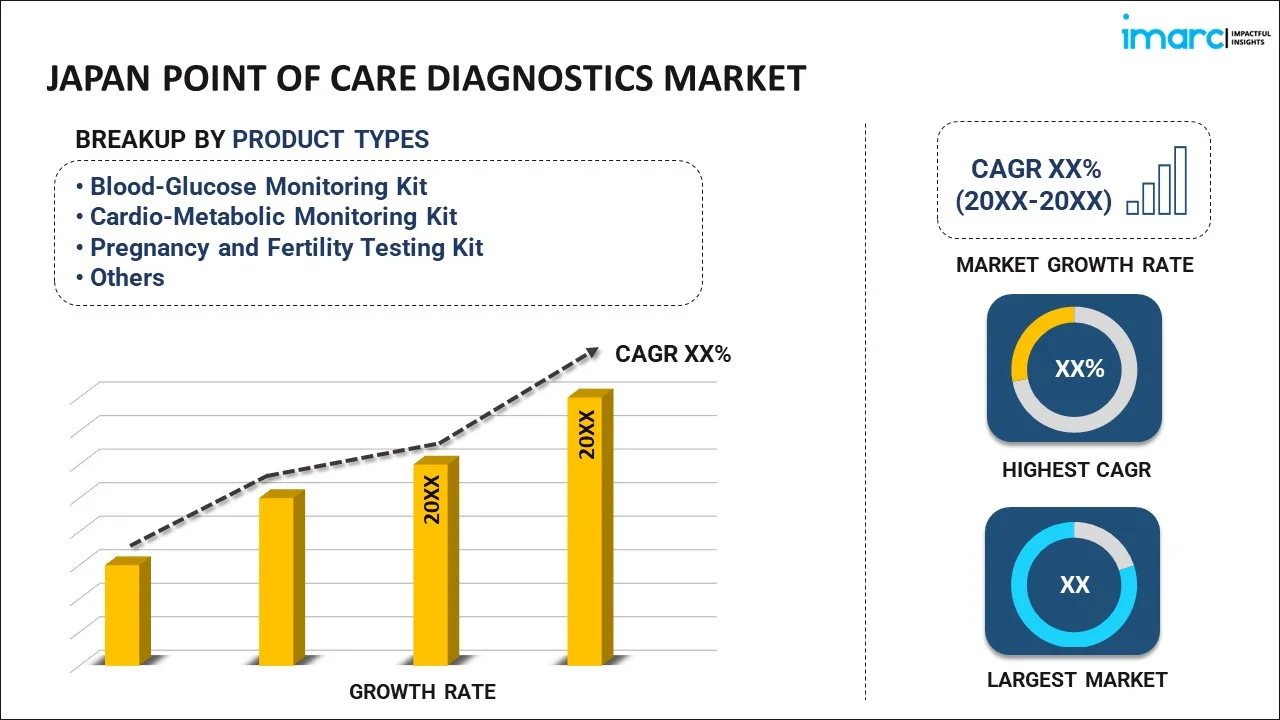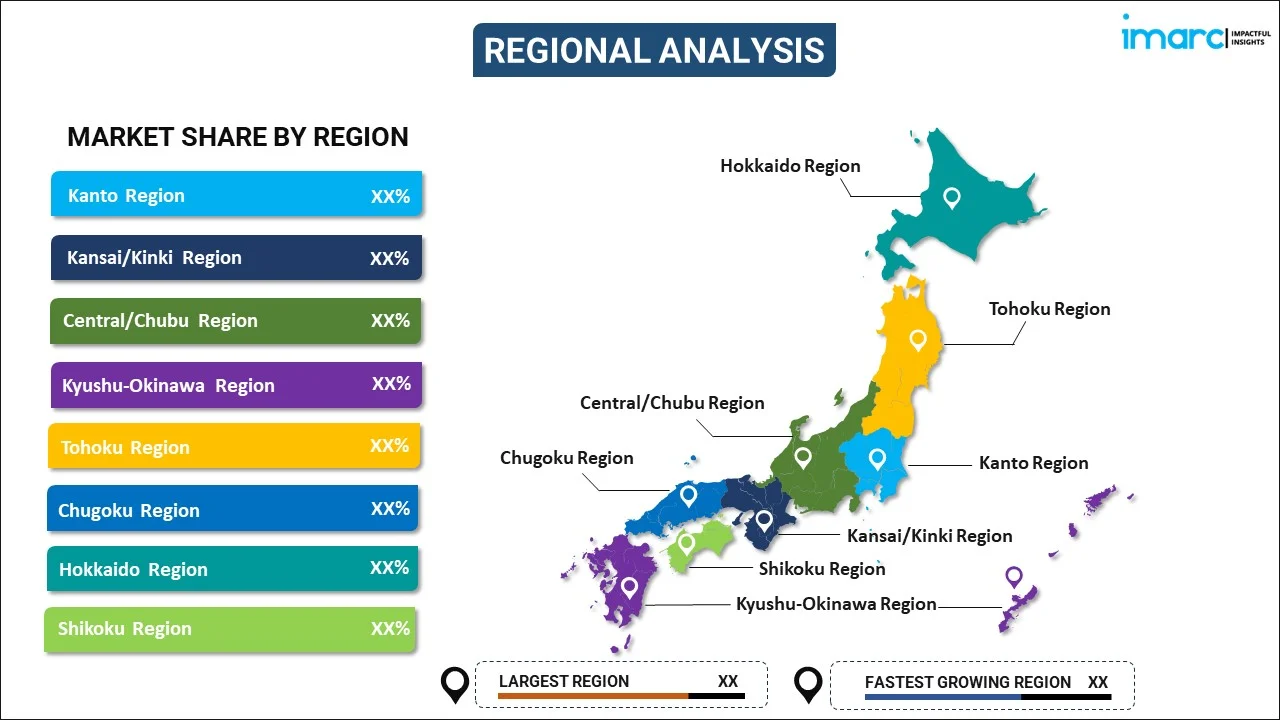
Japan Point of Care Diagnostics Market Report by Product Type (Blood-Glucose Monitoring Kit, Cardio-Metabolic Monitoring Kit, Pregnancy and Fertility Testing Kit, Infectious Disease Testing Kit, Cholesterol Test Strip, Hematology Testing Kit, and Others), Platform (Lateral Flow Assays, Dipsticks, Microfluidics, Molecular Diagnostics, Immunoassays), Prescription Mode (Prescription-Based Testing, OTC Testing), End User (Professional Diagnostic Centers, Home Care, Research Laboratories, and Others), and Region 2025-2033
Market Overview:
Japan point of care diagnostics market size reached USD 1.7 Billion in 2024. Looking forward, IMARC Group expects the market to reach USD 3.8 Billion by 2033, exhibiting a growth rate (CAGR) of 9.2% during 2025-2033. The increasing prevalence of chronic diseases like cancer, diabetes, and cardiovascular problems, shifting preferences towards community clinics, pharmacies, and home settings, and the expanding aging population represent some of the key factors driving the market.
|
Report Attribute
|
Key Statistics
|
|---|---|
|
Base Year
|
2024 |
|
Forecast Years
|
2025-2033 |
|
Historical Years
|
2019-2024
|
| Market Size in 2024 | USD 1.7 Billion |
| Market Forecast in 2033 | USD 3.8 Billion |
| Market Growth Rate (2025-2033) | 9.2% |
Point of care diagnostics (POCD) refers to medical tests conducted at or near the site of patient care, providing rapid results for immediate clinical decisions. It is user-friendly, requiring minimal training for healthcare professionals and encompasses a broad spectrum of tests for infectious diseases, chronic conditions, pregnancy, and various biomarkers. It enhances accessibility to medical testing, especially in resource-limited settings. It aids in preventing the spread of contagious diseases within communities or healthcare facilities. It reduces the need for multiple clinical visits, offering convenience and potentially lowering healthcare costs. It assists in managing and adjusting treatment plans based on real-time data. It is widely used in emergency medicine to quickly assess and diagnose critical conditions, such as cardiac events, sepsis, or respiratory distress.
Japan Point of Care Diagnostics Market Trends:
The increasing prevalence of chronic diseases like cancer, diabetes, and cardiovascular problems, coupled with this rising need for regular monitoring and immediate medical attention, represents one of the primary factors driving the demand for POCD in Japan. Additionally, the expanding aging population and the increasing hospitalization rates are facilitating the market growth. Along with this, rapid urbanization, changing lifestyles of individuals, and the rising risk of lifestyle-related diseases, such as obesity and hypertension, are driving the market in the country. POCD facilitates the timely monitoring and management of these conditions, leading to greater demand for POC testing devices. Apart from this, shifting preferences towards community clinics, pharmacies, and home settings are influencing the market positively. Moreover, governing authorities of the country are continuously focusing on the modernization of the healthcare sector, which is offering a favorable market outlook. They are implementing several initiatives and offering favorable reimbursement rates that encourage technological integration in healthcare services. Furthermore, the robust technology sector of Japan is actively engaged in miniaturization and automation, ensuring that POCDs meet the highest standards of reliability and usability. Along with this, rising collaborations between healthcare providers, diagnostic companies, and research institutions in Japan are creating a positive outlook for the market. These partnerships foster innovation and enable the development of tailored POC solutions for specific medical conditions. In addition, the rising shift towards preventive healthcare and early disease detection is bolstering the market growth. POC diagnostics empower individuals to monitor their health regularly, fostering a proactive approach to healthcare and reducing the burden on healthcare facilities. The growing awareness among the Japanese population about the importance of regular health check-ups is influencing the market positively.
Japan Point of Care Diagnostics Market Segmentation:
IMARC Group provides an analysis of the key trends in each segment of the market, along with forecasts at the country level for 2025-2033. Our report has categorized the market based on product type, platform, prescription mode, and end user.
Product Type Insights:

- Blood-Glucose Monitoring Kit
- Cardio-Metabolic Monitoring Kit
- Pregnancy and Fertility Testing Kit
- Infectious Disease Testing Kit
- Cholesterol Test Strip
- Hematology Testing Kit
- Others
The report has provided a detailed breakup and analysis of the market based on the product type. This includes blood-glucose monitoring kit, cardio-metabolic monitoring kit, pregnancy and fertility testing kit, infectious disease testing kit, cholesterol test strip, hematology testing kit, and others.
Platform Insights:
- Lateral Flow Assays
- Dipsticks
- Microfluidics
- Molecular Diagnostics
- Immunoassays
A detailed breakup and analysis of the market based on the platform have also been provided in the report. This includes lateral flow assays, dipsticks, microfluidics, molecular diagnostics, and immunoassays.
Prescription Mode Insights:
- Prescription-Based Testing
- OTC Testing
The report has provided a detailed breakup and analysis of the market based on the prescription mode. This includes prescription-based testing and OTC testing.
End User Insights:
- Professional Diagnostic Centers
- Home Care
- Research Laboratories
- Others
A detailed breakup and analysis of the market based on the end user have also been provided in the report. This includes professional diagnostic centers, home care, research laboratories, and others.
Regional Insights:

- Kanto Region
- Kansai/Kinki Region
- Central/ Chubu Region
- Kyushu-Okinawa Region
- Tohoku Region
- Chugoku Region
- Hokkaido Region
- Shikoku Region
The report has also provided a comprehensive analysis of all the major regional markets, which include Kanto Region, Kansai/Kinki Region, Central/ Chubu Region, Kyushu-Okinawa Region, Tohoku Region, Chugoku Region, Hokkaido Region, and Shikoku Region.
Competitive Landscape:
The market research report has also provided a comprehensive analysis of the competitive landscape. Competitive analysis such as market structure, key player positioning, top winning strategies, competitive dashboard, and company evaluation quadrant has been covered in the report. Also, detailed profiles of all major companies have been provided.
Japan Point of Care Diagnostics Market Report Coverage:
| Report Features | Details |
|---|---|
| Base Year of the Analysis | 2024 |
| Historical Period | 2019-2024 |
| Forecast Period | 2025-2033 |
| Units | Billion USD |
| Scope of the Report | Exploration of Historical Trends and Market Outlook, Industry Catalysts and Challenges, Segment-Wise Historical and Future Market Assessment:
|
| Product Types Covered | Blood-Glucose Monitoring Kit, Cardio-Metabolic Monitoring Kit, Pregnancy and Fertility Testing Kit, Infectious Disease Testing Kit, Cholesterol Test Strip, Hematology Testing Kit, Others |
| Platforms Covered | Lateral Flow Assays, Dipsticks, Microfluidics, Molecular Diagnostics, Immunoassays |
| Prescription Modes Covered | Prescription-Based Testing, OTC Testing |
| End Users Covered | Professional Diagnostic Centers, Home Care, Research Laboratories, Others |
| Regions Covered | Kanto Region, Kansai/Kinki Region, Central/ Chubu Region, Kyushu-Okinawa Region, Tohoku Region, Chugoku Region, Hokkaido Region, Shikoku Region |
| Customization Scope | 10% Free Customization |
| Post-Sale Analyst Support | 10-12 Weeks |
| Delivery Format | PDF and Excel through Email (We can also provide the editable version of the report in PPT/Word format on special request) |
Key Questions Answered in This Report:
- How has the Japan point of care diagnostics market performed so far and how will it perform in the coming years?
- What has been the impact of COVID-19 on the Japan point of care diagnostics market?
- What is the breakup of the Japan point of care diagnostics market on the basis of product type?
- What is the breakup of the Japan point of care diagnostics market on the basis of platform?
- What is the breakup of the Japan point of care diagnostics market on the basis of prescription mode?
- What is the breakup of the Japan point of care diagnostics market on the basis of end user?
- What are the various stages in the value chain of the Japan point of care diagnostics market?
- What are the key driving factors and challenges in the Japan point of care diagnostics?
- What is the structure of the Japan point of care diagnostics market and who are the key players?
- What is the degree of competition in the Japan point of care diagnostics market?
Key Benefits for Stakeholders:
- IMARC’s industry report offers a comprehensive quantitative analysis of various market segments, historical and current market trends, market forecasts, and dynamics of the Japan point of care diagnostics market from 2019-2033.
- The research report provides the latest information on the market drivers, challenges, and opportunities in the Japan point of care diagnostics market.
- Porter's five forces analysis assist stakeholders in assessing the impact of new entrants, competitive rivalry, supplier power, buyer power, and the threat of substitution. It helps stakeholders to analyze the level of competition within the Japan point of care diagnostics industry and its attractiveness.
- Competitive landscape allows stakeholders to understand their competitive environment and provides an insight into the current positions of key players in the market.
Need more help?
- Speak to our experienced analysts for insights on the current market scenarios.
- Include additional segments and countries to customize the report as per your requirement.
- Gain an unparalleled competitive advantage in your domain by understanding how to utilize the report and positively impacting your operations and revenue.
- For further assistance, please connect with our analysts.
 Inquire Before Buying
Inquire Before Buying
 Speak to an Analyst
Speak to an Analyst
 Request Brochure
Request Brochure
 Request Customization
Request Customization




.webp)




.webp)












